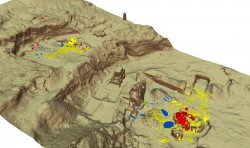Seminar: Drones ‘n Dinosaurs

By Pim Kaskes, MSc, PhD Researcher AMGC VUB
Drones ‘n Dinosaurs: An integrated 3D model of the Naturalis’ Triceratops Bonebed in Wyoming
Since 2013, the National Natural History Museum of the Netherlands, Naturalis Biodiversity Center, is unearthing the largest bonebed of the horned dinosaur Triceratops discovered so far. At least six individuals of Triceratops are identified and more than 900 bony elements are uncovered from this site of the Upper Maastrichtian Lance Formation in eastern Wyoming, USA. The bonebed consists of disarticulated skeletons chaotically positioned on top of each other and embedded in a variable matrix of organic rich silt and claystones and interfingering fluvial sandstones.
3D surveying, registration and visualization are useful in understanding the taphonomy and architecture of bonebeds, as has been proven in many archeological studies. In palaeontology, 3D models based on photogrammetry are widely used, but mainly for visualizing and archiving surfaces of specific bones, single specimens or fossil trackways. Here, a novel approach is presented that integrates geology, palaeontology and archeology to create 3D models of entire dinosaur excavation sites incorporating the spatial position of all skeletal remains and sedimentary layers.
Combining Terrestrial LiDAR, Drone photogrammetry, Total Station and GPS Base and Rover allows for detailed georeferencing of a fossil locality and makes stratigraphic correlations possible with sections close by. A multi-layered 3D model can be created and linked to a large GIS database generated over many years of excavation, displaying the vertical and lateral position of (distinct properties of) the sediments and the bones. Besides virtual (reality) applications in education and museum exhibits, this 3D model aids in linking specific bones to skeletons and helps to unravel the taphonomic history of complex bonebeds such as the Naturalis’ Triceratops site.